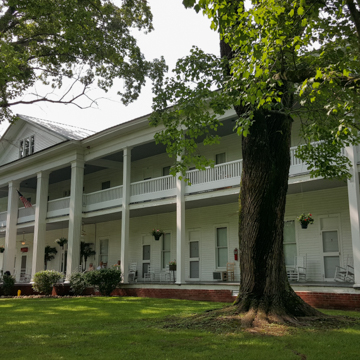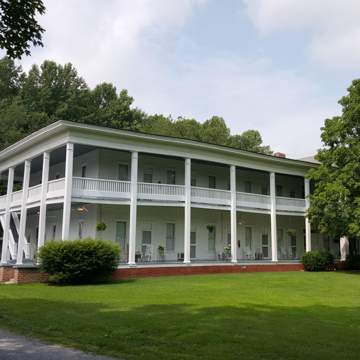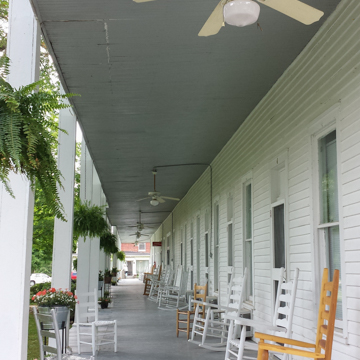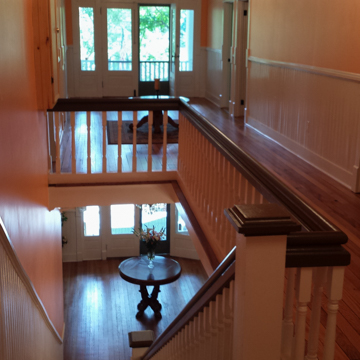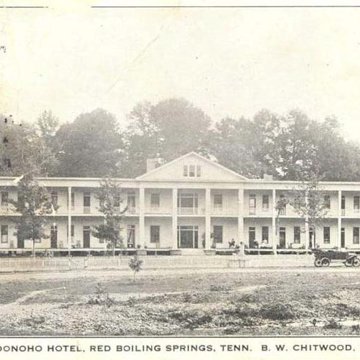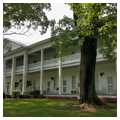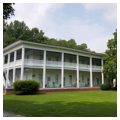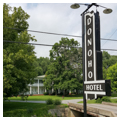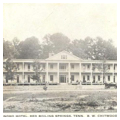The Donoho Hotel is a well-preserved example of a mineral springs resort hotel, which were once numerous in this part of Tennessee. Beginning in the early nineteenth century, dozens of resort hotels were built at mineral springs throughout Tennessee’s mountains and rugged highlands, such as Montvale Springs, Beersheba Springs, and Bon Aqua Springs. Located on the Highland Rim near the Kentucky Border, the isolated town of Red Boiling Springs was established in the mid-1840s as one of the first mineral springs resorts in Tennessee.
Situated at confluence of Salt Lick Creek and Whitley Branch, and containing large amounts of iron sulfate, the potent springs were thought to offer medicinal healing and curative powers for numerous ailments and sicknesses. The red-colored sulphur water gave the town its name. Red Boiling Springs contained five types of springwater, each with a unique name, taste, and purported healing effects.
By 1900, with improvements in transportation and marketing, Red Boiling Springs had become one of the most popular mineral springs resort towns in Tennessee, attracting visitors from the merchant and upper middle classes. A resort hotel has operated at this location since the 1890s. Squire Donoho (1863–1908) constructed the original three-story Donoho Hotel in 1901. By the time that building was destroyed by fire in August 1915, the Donoho was run by Brade Wilson Chitwood (1875–1958) and his wife Tennessee D. “Tennie” Whitley Chitwood (1882–1957), daughter of the original hotel operator. Prior to marrying Tennie Whitley in 1914, Chitwood was a salesman at a local general merchandise store. From 1919 until his death in 1957, Whitwood also served as president and owner of the Red Boiling Springs Bank. In 1916, the Chitwoods erected the current Colonial Revival building containing 36 private guest rooms along with a grand entrance lobby and a dining hall large enough for 128 guests.
This Donoho is distinguished by its two-story, wraparound veranda, supported by twenty-two square, fluted Doric columns and served by two sets of narrow staircases at each end. The veranda has tongue-and-groove oak floorboards and ceiling boards. A plain oak balustrade encases the upper floor of the veranda. The front entrance features a slightly protruding facing gable that forms a central pediment, supported by four oversized square Doric fluted columns.
The T-shaped building has narrow rectangular wings, a shallow side gable roof covered with metal panels, weatherboard siding, one-over-one wood sash windows, single-pane transoms above each entrance guest door, and a continuous brick foundation. The main central entrance has two double-leaf wood doors surmounted by transoms and flanked by sidelights. The opulent lobby featured chestnut wainscoting, hard wood floors, plaster walls, molded wood trim, hand-painted light fixtures, and a grand, straight-run staircase leading to the upper floor central hall. A lounge, the dining hall, gift shop, and check-in station are located off the lobby.
In 1924, the Chitwoods built a two-story, brick, Craftsman house as their private residence. Located on the west side of the hotel, this residence went on to serve as a manager’s house and is still standing. The property also retains a circa 1916 frame laundry and an 1890s stone fruit cellar, as well as two modern gazebos and a modern covered footbridge spanning the Salt Lick Creek. A rear kitchen wing with a cook’s quarters was added to the main building in the 1930s.
During its peak in the 1920s and 1930s, Red Boiling Springs boasted nine resort hotels and over a dozen boarding houses, accommodating thousands of summer guests from across the country, including governors, congressmen, senators, and President Woodrow Wilson, who stayed at the Donoho. During the summer of 1936, the town’s year-round population of 800 swelled to more than 14,000.
Besides resort hotels, the town’s tourism industry also supported bathhouses, a recreational lake and amusement park, bowling alleys, tennis courts, shuffleboard, croquet, a ballroom, swimming pools, horseback riding, a small golf course, theater, restaurants, pottery souvenirs, and a Nestlé springwater bottling plant. Taverns were located at the town’s periphery. At times, orchestras and big bands played night and day for dancing. After World War II, the town entered into a period of decline, exasperated by a flood in 1969.
The Chitwoods operated the Donoho Hotel until 1955, when they sold it to Edgar Decatur Hagen (1902–1980), a former postmaster. Hagen undertook major improvements in 1956 such as installing private guest bathrooms and new lighting systems. Edith Walsh (1929–1999) operated the hotel from 1973 to 1994 and since 2001 Robert and Pauline Stroop have owned the Donoho. They renovated the interior in 2014. The landscaped front lawn retains mature trees, a concrete vehicular bridge spanning the creek, and metal entrance sign dating from the 1950s.
Today, the Donoho is one of three historic hotels that continue to operate at Red Boiling Springs.
References
Birdwell, Michael, and W. Calvin Dickinson, eds. Rural Life and Culture in the Upper Cumberland. Lexington: University of Kentucky Press, 2004.
Brandt, Robert. Touring the Middle Tennessee Backroads. Winston-Salem, NC: John F. Blair Publisher, 1995.
Brenden, Martin C. “Historic Resorts.” Tennessee Encyclopedia of History and Culture. Version 2.0, Online Edition. Nashville: Tennessee Historical Society, 2000–2018. http://tennesseeencyclopedia.net/.
Lane, Pat, “Early Twentieth Century Resort Buildings of Red Boiling Springs,” Macon County, Tennessee. National Register of Historic Places Inventory-Nomination Form, 1986. National Park Service, U.S. Department of the Interior, Washington, D.C.
Lane, Pag, “Donoho Hotel Historic District,” Red Boiling Springs, Macon County, Tennessee. National Register of Historic Places Inventory–Nomination Form, 1986. National Park Service, U.S. Department of the Interior, Washington, D.C.
Sirna, Angela, Sara Dusenberry, and Elizabeth Humphreys, “Red Boiling Springs Bank,” Red Boiling Springs, Macon County, Tennessee. National Register of Historic Places Inventory–Nomination Form, 2012. National Park Service, U.S. Department of the Interior, Washington, D.C.














